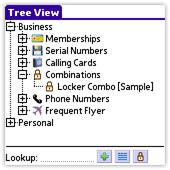SplashID provides quick and easy access to all of your personal identification
information, including usernames, passwords, credit cards, PINs, calling
card numbers, frequent flyer numbers, insurance info and more. Data
is stored in a secure, encrypted, password protected format and can
be synchronized between SplashID on your Palm OS handheld and SplashID
on the desktop (Windows and Macintosh).
SplashID 4 is currently available for Windows users only. Mac development
is underway.
Press Resources
A complete user's guide, including detailed installation instructions,
can be downloaded here:
You can find resources for the press, including press
releases, in our News section:
You can stay up-to-date on the latest happenings with SplashData at
our
blog:
Please feel free to use the images in this guide for review purposes,
or contact us for additional images if needed.
|
Important notice to upgraders!
-
If you are upgrading from an older version, it is recommended
that you export a backup of your SplashID desktop data before
running SplashID 4, as there have been changes in the database
structure and we cannot guarantee that the upgrade will be flawless.
To export a backup, you must be running SplashID 2.11 or later:
File > Export > SplashID vID
|
Run the Installer and follow the on screen instructions. You will be
required to HotSync your Handheld to complete the installation. The
installer installs the following files:
- SplashID -- A Palm OS application used to view and edit information
on the handheld.
- SplashID Desktop -- A desktop application (for Mac and Windows)
used to view and edit information on the desktop.
- SplashID Conduit -- A HotSync Conduit used to synchronize
data between the handheld and the desktop.
- SplashID User Guide -- This User Guide.
After the HotSync operation is complete, go to the Palm Applications
Launcher and tap the SplashID icon to launch SplashID.
When you launch SplashID you will be prompted to enter a registration
code or to run in Trial mode. You may run the software for 30-days in
full-functioning Trial mode. The Trial software and Registered software
are identical. Once the trial period ends you must purchase and enter
a registration code to continue using the software. You do not need
to re-install the software. Simply enter a registration code and your
Trial version will be converted into a Registered version and all your
data will remain intact. The registration code must be entered
in both the desktop application and the Handheld application.
Upgrades -- If you are upgrading from an older version to version
4.x, you will need to purchase the upgraded registration code for $9.95.
Quick Start
- When you first launch SplashID, you will see the Getting Started
wizard. It will take you through the basic functionality in 3 quick
steps.
- After the wizard completes. you will land on the Set
Password screen.
You can check the box to set no password if you wish, and you can
set a hint to remind you.
- Launch SplashID and the List View will
be displayed with several sample records. You can also select the
Tree View button to view your records in a tree format.
- Tap New to create a new record. In the Edit
Dialog select a Type, such as Credit
Card or Web Login, and you will see the Field
Labels
change accordingly.
- Tap Done when you are finished entering the information for the
new record and you are returned to the List View.
- You can create records on the handheld or the desktop and synchronize
the data between the two. You may find it easier to enter data in
SplashID Desktop where you can use your keyboard.
What's new in version 4?
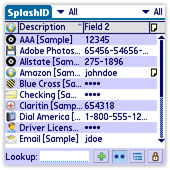
|
- Toolbar -- A new contextual toolbar has been added to give
quick access to priority functionality. 5-way navigation is supported
throughout.
- Lookup -- Enter text into the Lookup field at the bottom
of the screen to select the first matching item in the list.
- Several buttons appear at the bottom of the List View screen:
 New --
creates a new record within the current Type
and Category. New --
creates a new record within the current Type
and Category. Mask --
show/hide masked fields. Mask --
show/hide masked fields. Tree
View -- brings you to the Tree
View. Tree
View -- brings you to the Tree
View.  Lock --
Locks SplashID immediately and requires a password to open
the data again. See Security for
more information. Lock --
Locks SplashID immediately and requires a password to open
the data again. See Security for
more information.
|
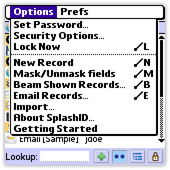 |
Menus have been improved overall, with some new
features:
- Shortcuts -- More menu shortcuts are available
for quick access to advanced users.
- Email Records -- Exports a secure vID
file and attaches it to a new email message in the email
program you select.
- Getting Started -- Launches the Getting
Started wizard.
|
Active URLs
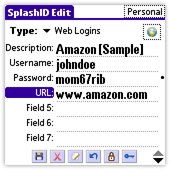
|
Enter the Edit Dialog and you will see a number
of updated features. One feature Treo users will love is the active
URL links. Just tap the URL field and you will be asked if you
want to launch the web browser with that destination.
|
Updated Icons
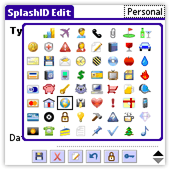
|
The icons in the Icon Picker have been updated
for a better high resolution look and feel.
In addition, SplashID supports Custom icons which are available
from third-party vendors, as well as icons created with icon
editing applications like Icon Manager.
|
More Fields
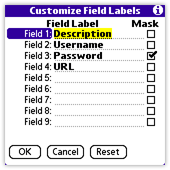
|
Four additional fields were added, including 3 that the user
has access to, bringing the total number of fields to 10 plus
a Notes field. The 10th field is the date modified field, which
will dynamically update to show the last date the record was
modified, which is useful for regularly changing passwords or
duplicate compare.
Additionally, any field witih a label of "Date" will offer a
convenient date picker tool to select the appropriate date.
Field Labels and masking are set by default when you define
a Type. You may change the Field Labels
and masking, however, at the record level by tapping the Field
Label itself, or by choosing Customize Field Labels from the
Edit Dialog Menu Options.
|
Automatic Password Generator
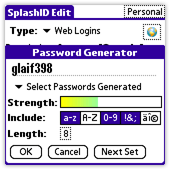
|
There are three ways to bring up the Automatic
Password Generator in Edit Dialog:
- Select the Password Generator button from the toolbar.
- Tap the bullet next to a masked field.
- Choose Password Generator from the Options menu.
To create a password:
- Choose from the Include table one or more options of letters,
numbers, symbols, or a combination thereof. The Strength meter
will show you how strong the password will be based on the
selected attributes.
- Set the Length.
- Check or uncheck the pronounceable setting.
- Tap Generate. A list of 10 passwords will be displayed in
the "Select Passwords Generated" menu.
- Tap Next Set to refresh the list of generated
passwords.
- Tap OK when you have decided.
|

Set Password Dialog |
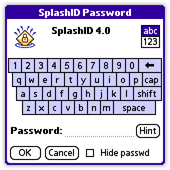
Enter Password Dialog |
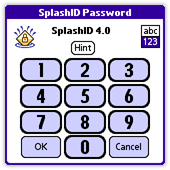
Numeric Keypad option |
- Setting a Password -- The Set
Password dialog is now displayed on the first launch, after the
Getting Started wizard completes. Enter a password in the New Password
field, and verify the password by entering it again in the Confirm
field.
- Hint -- You
can enter a hint to remind you of your password if you forget.
- Password Generator -- You
can also use the password generator tool in this dialog, but keep
in mind that these are generally strong passwords and difficult to
remember.
- Security Options -- Choose Security Options from
the Options menu to specify the period of time that must elapse before
SplashID auto-locks. The default setting is 3 minutes.
- Password Lock-out -- If you enter the incorrect password 5 times,
you will be warned that you have only 5 attempts left. After 10 failed
attempts to login, the application will be locked and the data can
only be erased to start over.
|
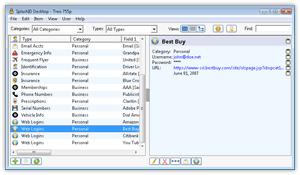
List View
|
SplashID Desktop
has been completely revamped. Desktop is similar to SplashID
on the Handheld, with the following additional features:
- 3 Record Views -- Use the View buttons to
select from the traditional List View, or the new Panel and
Tree Views. Select a record from the List to display the details
in the Detail Pane on the right.
- Web Auto-Fill -- For Web Logins, click the globe
button or right click and select Auto-Fill to open Internet
Explorer to the selected URL and fill in the login info with
your data. See Web Auto-Fill for more
info. Or you may simply click on a URL or email address in
the preview pane to launch your web browser or email client.
- Database Sync -- You may select multiple databases to synchronize
with on the desktop, so you can share data with other users,
even across a network. See Database Sync
for more info.
- Find -- Enter a few letters in the Find
box to instantly display results in the view below.
|
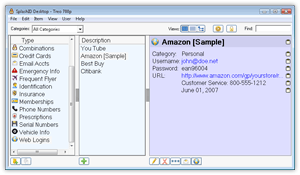
Panel View |
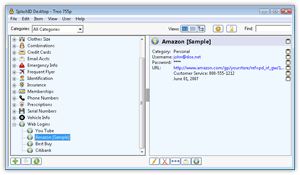
Tree View |
Buttons
There are buttons scattered around the SplashID Desktop window, situated
by proximity to where they are to be used:
|
   -- Views:
Switch between Panel View, List View, and Tree View, respectively. -- Views:
Switch between Panel View, List View, and Tree View, respectively.
|
|
 -- Options:
Opens the Options dialog (below). -- Options:
Opens the Options dialog (below).
|
|
 -- Lock
Now : Locks SplashID immediately and requires a password
to open the data again. -- Lock
Now : Locks SplashID immediately and requires a password
to open the data again.
|
|
 -- New
Type: Opens the Edit Type Dialog for a new Record
Type. Available in Panel View only. -- New
Type: Opens the Edit Type Dialog for a new Record
Type. Available in Panel View only.
|
|
 -- Duplicate
Record: Opens the Edit Record Dialog for a duplicate
of the selected record. -- Duplicate
Record: Opens the Edit Record Dialog for a duplicate
of the selected record.
|
|
 -- Show
Details : Shows or hides the Record Detail Pane. -- Show
Details : Shows or hides the Record Detail Pane.
|
|
 -- New
Record: Opens the Edit Record Dialog for a new record. -- New
Record: Opens the Edit Record Dialog for a new record.
|
|
 -- Edit
Record: Opens the Edit Dialog for the selected record.
You can also double click the record.
-- Edit
Record: Opens the Edit Dialog for the selected record.
You can also double click the record.
|
|
 -- Delete
Record: Deletes the selected record. You can also
hit the Delete key. -- Delete
Record: Deletes the selected record. You can also
hit the Delete key.
|
|
 -- Mask/Unmask:
Masks/Unmasks field data that has been specified as masked.
-- Mask/Unmask:
Masks/Unmasks field data that has been specified as masked.
|
|
 -- Email
Records: Exports selected or all records to vID file,
then attaches it to a new email.
-- Email
Records: Exports selected or all records to vID file,
then attaches it to a new email.
|
|
 -- Web
Auto-Fill : Launches Internet Explorer and fills in
record data for selected URL. More info. -- Web
Auto-Fill : Launches Internet Explorer and fills in
record data for selected URL. More info.
|
Options
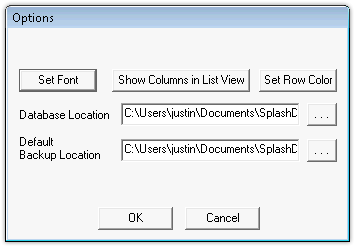
|
When you click the Options button  or
select Options from the Edit menu, you will see the dialog to
the left, with the following options: or
select Options from the Edit menu, you will see the dialog to
the left, with the following options:
- Set Font -- Select the Font type, style,
size and color from the fonts on your system.
- Show Columns in List View -- Select which field data columns
you would like to display in the List View.
- Set Row Color -- Select the color of the
rows in List View, which will also be applied as the background
color in the Panel and Tree Views.
|
- Database Location -- Select a Custom database location, including
network locations. Note: You cannot select a folder that already
contains a SplashID database. See Database Sync if you wish to share
data.
- Backup Location -- Change the location that
the automatic vID backup is saved to.
Web Auto-Fill
For Web Logins, you can have SplashID
launch Internet Explorer and automatically fill in the username and
password fields for you. Please take note of the following:
- Record type must be assigned to Web Logins.
- Username and password fields should be filled in.
- URL field must begin with either http:// or www. Find the correct
URL to get to the login screen on the selected website -- this is
often not the homepage.
- On Vista and/or Internet Explorer 7, you must disable Protected
Mode in:
- Tools > Internet Options > Security > Uncheck "Enable Protected
Mode"
- Click Apply, then restart Internet Explorer.
- This may not work with all sites.
Database Sync

New in SplashID 4, you can synchronize multiple database files manually,
at launch, and/or at exit. This is an advanced feature, not recommended
for beginner users. As always, it is recommended that you backup your
data with a vID export before trying out this feature, so you can revert
if you lose anything. Please Note: You can only sync
with other SplashID 4.x database files. At the time this User Guide
was written, that means only SplashID 4 for Palm OS users and SplashID
4 Desktop Only users.
To synchronize multiple database files:
- Click Add File and select a remote database to sync with.
(Your database does not need to be selected).
- Select the Sync Mode
- Synchronize -- Compares the databases and writes changes to
each.
- Current to Remote -- Overwrites remote data with current
user data.
- Remote to Current -- Overwrites current user data with remote
data.
- Set In Case of Conflict -- Current wins or Remote wins.
- Set Sync on Startup preference.
- Set Sync on Exit preference.
- Check the boxes for the databases you would like to sync.
- Select Sync Selected or Sync Now.
|


